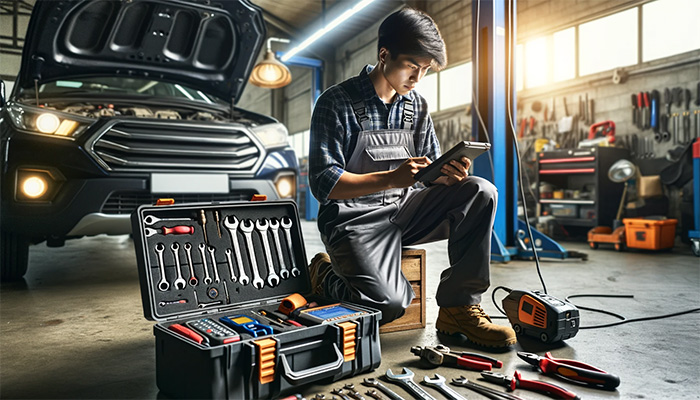Tools of the Trade: A Journey Through Essential Mechanic Tools Over the Years
By: Luke Shaff ~
10/26/2023

For anyone deeply involved in the automotive repair industry, tools aren't just tools – they're the lifeblood of the job. They're the extensions of a mechanic's hands, the key to unlocking the mysteries of an engine, and the solution to a car's woes. But as cars have evolved, so have the tools that service them. Let's take a nostalgic drive through the essential tools every mechanic should have and see how they've changed over the decades.
- Wrenches: Then and Now
Then: The classic open-end and box-end wrenches were a staple in every mechanic's toolbox. Made of sturdy steel, they were the go-to for most under-the-hood tasks.
Now: While traditional wrenches still hold their ground, ratcheting wrenches have become a favorite. They save time with their continuous motion, and the flare nut wrench, in particular, has grown in popularity for its grip on softer metals.
- Screwdrivers: More than Just a Twist
Then: Flathead and Phillips were the primary choices. Their uses were simple, and their design, even simpler.
Now: With cars becoming more complex, the variety of screws used has expanded. Torx, hex, and even security screwdrivers have become essentials, each designed for a specific type of fastener.
- Diagnostic Tools: A New Age Revolution
Then: Listening closely to the engine and using intuition was often the primary diagnostic method. Simple gauges helped measure things like oil pressure.
Now: OBD (On-Board Diagnostics) scanners have transformed diagnostics. These digital tools provide detailed error reports, making it easier to pinpoint issues quickly.
- Jacks: Lifting the Burden
Then: Manual, heavy-duty jacks required elbow grease but were reliable for lifting vehicles.
Now: Hydraulic jacks and lifts have become more common, offering a safer and more efficient way to elevate cars. Some are even portable and can be controlled with a foot pedal.
- Pliers: The Grip Evolution
Then: Standard pliers, often heavy and broad, were used for a range of tasks, from cutting wires to holding parts.
Now: The plier family has expanded. Needle-nose pliers, channel locks, and wire strippers cater to specific tasks, ensuring precision in every grip.
- Power Tools: Embracing Technology
Then: Hand tools were the norm, and while effective, they demanded time and effort.
Now: Cordless drills, impact wrenches, and electric ratchets have surged in popularity. They not only save time but also ensure consistency in tasks like tightening bolts.
- Lighting: Illuminating Progress
Then: Handheld torches or simple overhead lights were the primary sources of illumination.
Now: LED work lights, headlamps, and even endoscopic cameras offer targeted lighting, making it easier to work in tight, dark spaces.
As we reflect on these changes, it's evident that while the essence of repair remains the same, the tools have adapted to the times, becoming more specialized and efficient. For mechanics old and new, understanding and adapting to these changes is crucial. After all, in a profession where precision and efficiency are paramount, having the right tool for the job isn't just a convenience – it's a necessity.
Whether you're just starting your journey as a mechanic or have grease under your nails from decades in the trade, always remember: it's not just about having the tools, but knowing how to use them to their fullest potential. Here's to the tools of our trade, past, present, and future!
 Luke Shaff
Luke Shaff